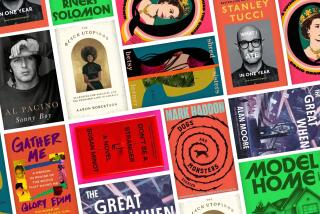A RUSH OF FILM BOOKS FROM ACADEMIA
- Share via
The walk-in movie business may be in a slump, despite the odd burp on the curve indicating “Rocky IV” or another isolated hit, but the movie book business appears to be flourishing. Books about films, film makers and film stars continue to appear in what seems like a flood tide.
The tide divides, as always, into two streams. There are the cut-and-paste film star biographies, seldom enriched by any direct contact between the star and the author, but retailing and retelling the stuff of previous clips. And, increasingly, there are the dead-serious scholarly examinations, usually now published by the university presses.
The scholarly books are a significant shift, historically, from earlier days when films were thought to be beneath academic notice. The danger, which is real, is that the scholars will denude the movies of their vitality and popular appeal, as they have done their best to deprive Shakespeare of his. You are reminded of E. B. White’s comment on a book analyzing American humor. The author, White said, had got American humor down, and broken its arm.
Yet even with the attendant risks of overinterpretation, the new rush of books from the campus is heartening in the authors’ insistence on taking the movies seriously.
Raymond Carney, who teaches at Middlebury College, has done “American Dreaming: The Films of John Cassavetes and the American Experience” (University of California, $27.50) and finds an embracing context for Cassavetes’ challenging work.
The academic language takes a certain amount of forgiveness (“The family becomes the model for all performative relations in Cassavetes’ work”). But it is decipherable, which is more than can be said for certain semiotic works in translation.
“Erik Erikson,” Carney writes, “said that the central problem of the American personality is the unending and ever revised quest for identity, and Cassavetes’ films take as their subject crises of identity at least as profound as those Erikson described.” Carney celebrates Cassavetes’ “confidence in the power of the self to reform itself in exhilarating, life-affirming performances.” His idealism, says Carney, is his faith in the power and agility of his characters.
It’s a way of seeing, which Carney details at length.
Not recent but intriguing is “Hollywood and the Catholic Church” by Les and Barbara Keyser, husband and wife and both college teachers (Loyola University Press, Chicago, $12.95). The survey is from “Intolerance” (sympathetic) to the present (far less so, despite “Rocky” and its portrayal of traditional ethnic faith).
“In the Hollywood catechism,” say the Keysers, “Catholics have more capacity for suffering than for joy. Most contemporary portraits of ethnic Catholicism are dark portraits of stunted lives, compulsive guilt, and abiding despair.” They cite most of the characterizations in “Absence of Malice” as a perfect instance, notably the suicide of the parochial schoolteacher who has had an abortion.
That was indeed a fair distance from “Going My Way,” yet a case can be made that as between sentimental piety and social accuracy, other current films strike a better balance. Faith is at least occasionally seen as a conscious choice (the mother superior in “Agnes of God”), not a ritual inheritance. But the book is a provocative study, with a clear point of view.
The best of the new books are invaluable shelf reference works. Roy Armes’ “French Cinema” (Oxford University Press, $10.95 paper, $25 cloth) is an elegantly but economically written survey from Lumiere to Rohmer, full of insights and tugs at memory.
“The Making of ‘Citizen Kane’ ” by Robert L. Carringer (University of Illinois Press, $22.50), who teaches English and cinema studies at Illinois, re-creates the production of the film through interviews with the surviving creators and research in text sources. It concludes, very reasonably indeed, that no small part of Orson Welles’ genius lay in his choice of collaborators, and that “Kane” is first and finally a work of exquisite collaboration. If it dislodges no preset opinions on the primacy of Welles vs. Herman Mankiewicz, it is an engrossing stroll through the days of the greatest American film ever made.
Finally, just out in paperback is a revised edition of Tino Balio’s “The American Film Industry” (University of Wisconsin Press, $12.50), a fat, helpful compilation of articles about the beginnings and growth of the movies as indeed a business, not, in this selection, an art form. Balio, who teaches at Wisconsin, includes his own researches on the founding of United Artists, and there are readings from John Cogley on blacklisting and Richard Randall on film censorship.
Enough to see anyone through a long winter’s night or two.
More to Read
Sign up for our Book Club newsletter
Get the latest news, events and more from the Los Angeles Times Book Club, and help us get L.A. reading and talking.
You may occasionally receive promotional content from the Los Angeles Times.










